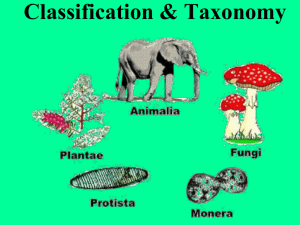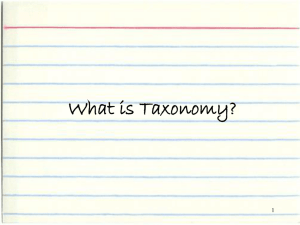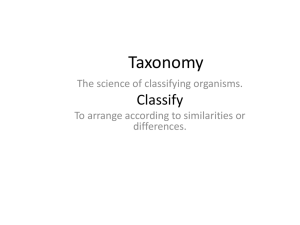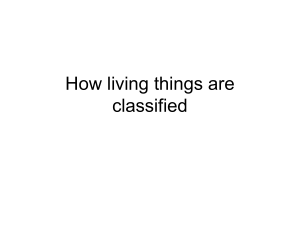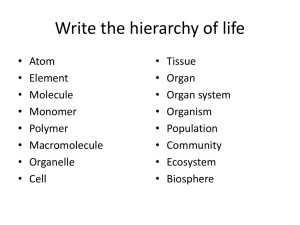Binomial Nomenclature
advertisement
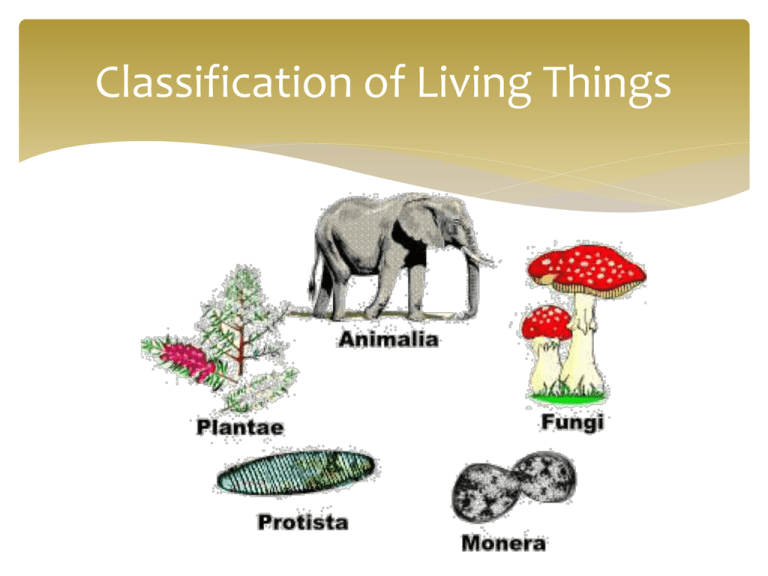
Classification of Living Things Classification of Living Things Taxonomy: science of classification Branch of biology that names organisms according to their characteristics, and places them into orderly groups based on similar characteristics. Why ? Biologists classify living organisms to answer questions such as: - How many known species are there? - What are the defining characteristics of each species? - What are the relationships between these species? Aristotle Aristotle Greek philosopher and teacher more than 2000 years ago The first person to devise a classification system-according to natural environment (350 B.C.) Aristotle PLANTS: Based on size of stem ANIMALS: Based on where they lived John Ray 17th Century Classified according to characteristics Why are there problems with this??? Limitations of Early Classification 1. Not all organisms fit into Aristotle’s 2 groups (plants or animals) Ex: Bacteria Fungi Images from: http://www.leighday.co.uk/upload/public/docImages/6/Listeria%20bacteria.jpg http://danny.oz.au/travel/iceland/p/3571-fungi.jpg Limitations of Early Classification 2. Common names can be misleading Ex: A jelly fish isn’t a fish, but a seahorse is! Sea cucumber sounds like a plant but… it’s an animal! Image from: http://www.alaska.net/~scubaguy/images/seacucumber.jpg Limitations of Early Classification 3. Common names vary from place to place Ex: puma, catamount, mountain lion, cougar are all names for same animal Image from: http://www4.d25.k12.id.us/ihil/images/Cougar.jpg Limitations of Early Classification 4. Same organisms have different names in different countries. Chipmunk Streifenhornchen (German) Tamia (Italian) Ardilla listada (Spanish) Image from: http://www.entm.purdue.edu/wildlife/chipmunk_pictures.htm Limitations of Early Classification Early Solution: Description of Organism Using Latin Names RED OAK Quercus foliis obtuse-sinuatis setaceo-mucronatis “oak with leaves with deep blunt lobes bearing hairlike bristles” Limitations of Early Classification Problem with Latin Name descriptions? - Names too long and difficult to remember - Names don’t illustrate evolutionary relationships Carolus Linneaus Devised a new classification system based on morphology (Organism’s form and structure) Formed a species Similar species group together to form a genus (1707-1778) “Father” of taxonomy and binomial nomenclature Use of genus and species names to form scientific name This system is called binomial nomenclature Binomial means two parts Nomenclature means system of naming Latin is used-dead language Binomial Nomenclature Binomial Nomenclature: Two name naming system Italicized or Underlined 1st Name = Genus Capitalized 2nd Name = Species Identifier Lower case Binomial Nomenclature Vampire bat Desmodus rotundus Image from: http://212.84.179.117/i/Vampire%20Bat.jpg Eastern chipmunk Tamias striatus Image from: http://www.entm.purdue.edu/wildlife/chipmunk_pictures.htm Binomial Nomenclature Humans Homo sapiens Homo sapiens Image from: http://www.earlylearning.ubc.ca/images/photo_baby.jpg Robert Whittaker-1969 5 kingdom system of naming Animalia, Plantae, Protista, Monera, Fungi Levels of classification from broadest to narrowest KPCOFGS Kingdom Phylum Class Order Family Genus Species Kings Play Cards On Fat Green Stools Kingdom Animalia Phylum Chordata Class Mammalia Order Carnivora Family Felidae Genus Panthera Species leo http://www.vetmed.wisc.edu/dms/fapm/personnel/tom_b/2004-lion.jpg Modern Taxonomy Modern taxonomy involves early naming/classification system, but with additional kingdom. Domain is the most general grouping Modern Taxonomy Organizes living things in the context of evolution Modern Taxonomy Scientists use a variety of information in order to classify organisms: 1. Chromosome Structure 2. Reproductive Potential 3. Biochemical Makeup/Protein Comparison 4. Morphology- Homologous Structures 1. Chromosomes Similar karyotypes suggest closer relationships. Indicates similar DNA/RNA structure by comparing base sequences Human: http://www.nationmaster.com/wikimir/images/upload.wikimedia.org/wikipedia/en/thumb/1/18/300px-Human_karyogram.png Chimpanzee: Middle School Life Science , published by Kendall/Hunt. Human- 46 chromosomes Chimpanzee- 48 chromosomes Even differences show relatedness Chimpanzees have 2 smaller chromosome pairs we don’t have Humans have 1 larger chromosome pair (#2) they don’t have. Human: http://www.nationmaster.com/wikimir/images/upload.wikimedia.org/wikipedia/en/thumb/1/18/300px-Human_karyogram.png Chimpanzee: Middle School Life Science , published by Kendall/Hunt. 2. Reproductive potential If two organisms can interbreed AND produce fertile offspring they are considered of the same species 3. Biochemical makeup Comparison of macromolecules such as Proteins Similar amino acid sequences in proteins indicate similar organisms Macromolecules 4. MORPHOLOGY Shape and Function Image from: http://www.angelfire.com/ab7/evolution12/evolutionclues.html Morphology Homologous Structures: Embryological source of similar structures indicate a possible common ancestor Example: Bat Wing and Human Arm P. 262 Morphology Bat wing and human arm develop from same embryonic structures HOMOLOGOUS STRUCTURES Morphology Analogous Characteristics: May have similar function, but different embryological origin Example: Bird Wing and Butterfly Wing Analogous characteristics evolved separately. Organisms not necessarily closely related. ANALOGOUS STRUCTURES Bird wing and butterfly wing have evolved with similar function BUT different structure inside. http://uk.dk.com/static/cs/uk/11/clipart/bird/image_bird003.html Insects and birds NOT closely related! http://www.naturenorth.com/butterfly/images/05a%20tiger%20wing.jpg I don’t get it?! Think in terms of structure. Analogous characters the same function but different underlying structure. Homologous characters different functions, but similar structure inherited from a common ancestor. **Important for cladograms!** Cladistics Reflect an organism’s evolutionary history Shows evolutionary relationships based on “shared derived characteristics” Cladistic relationships illustrated through the use of a Cladogram Phylogeny: Evolutionary History Cladogram The greater the number of derived characters shared by groups, the more recently the groups share a common ancestor. Dichotomous Key A dichotomous key is used to classify an organism by physical characteristics. Made of couplets of opposing meaning. Domain Bacteria Archaea Eukarya Kingdom Eubacteria Archaebac- Protista teria Fungi Plantae Animalia Cell type Prokaryote Prokaryote Eukaryote Eukaryote Eukaryote Eukaryote Cell structure Cell walls with peptidoglycan Cell walls w/o peptidoglycan Cell walls of cellulose in some; some have chloroplasts Cell walls of chitin Cell walls of cellulose; chloroplast No cell walls or chloroplast Number of cells Unicellular Unicellular Most unicellular; some colonial; some multicellular Most Multicellular multicellular; some unicellular Multicellular Mode of nutrition Autoroph or heterotroph Autoroph or heterotroph Autoroph or heterotroph Heterotroph Autotroph Heterotroph Mushroom, yeast Mosses, ferns, flowering plants Sponges, insects, fish, mammals Examples Streptoccous, Methanogen Amoeba, E. coli , halophiles Paramecium, slime molds, giant kelp
